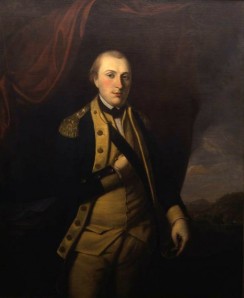LAFAYETTE MEMORY SPACES
LIEUX DE MÉMOIRE LAFAYETTE
By Gérard CHARPENTIER Ph. D.
Grand-Cross, Commander Ordre Lafayette
President:

« Ordre Lafayette Order America Corp. » / USA
*A Nonprofit organization classified exempt under IRS code 501(c) (3)
http://www.ordrelafayette-usa.org
https://ordrelafayetteusa.home.blog/
« Association Ordre Lafayette Canada »
http://www.ordrelafayette-canada.org
https://ordrelafayettecanada.home.blog/
« Association Ordre Lafayette International« –« Organisation Réseau Monde »
http://www.ordrelafayette-international.org
https://ordrelafayetteinternational.wordpress.com/
WHAT IS A MEMORY SPACE?
The “Memory space” is a concept coined by French historian Pierre Nora between 1984 and 1992 related to collective memory, stating that certain places, objects or events can have special significance related to group’s remembrance. At once natural and artificial, simple and ambiguous, concrete and abstract. It may therefore be an important figure, an object, a monument, a statue, a place, a site, a plaque, a museum or archives … as well as a symbol, a currency, a cause, a song, a text an event or institution …
Le «Lieu de Mémoire» est un concept mis en avant par l’historien français Pierre Nora entre 1984 et 1992 qui explique qu’un «objet» «devient lieu de mémoire quand il échappe à l’oubli, par exemple avec l’apposition de plaques commémoratives, et quand une collectivité le réinvestit de son affect et de ses émotions» «un lieu de mémoire dans tous les sens du mot va de l’objet le plus matériel et concret, éventuellement géographiquement situé, à l’objet le plus abstrait et intellectuellement construit» Cela peut être un personnage important, un monument, un musée ou des archives … tout autant qu’un symbole, une devise, un texte, un événement, ou une institution.
INTRODUCTION ABOUT THE AMERICAN REVOLUTION 1777-1782
*LAFAYETTE INVOLVEMENT
Lafayette played a key role during the American Revolutionary War (1775–1783).
Gilbert du Motier, marquis de La Fayette – Major General of the Continental Army
He enlisted as a volunteer without pay alongside the « Insurgents » of the 13 English colonies in America who declared independence unilaterally July 4, 1776.
*First military campaign: from June 1777 to January 1779.
*Back in France to plead the cause of the “Insurgents”: from February 1779 to March 1780.
*Second military campaign: from April 1780 to December 1781.
Today, many Places in the United States (town, city, village, county, township… Historic, natural sites…) may refer or are named for General Gilbert du Motier, marquis de La Fayette, or La Grange “Home” of Lafayette.

The Château de Chavaniac is a fortified manor house in Chavaniac-Lafayette, France and was built in the 14th century. It was the birthplace of General Lafayette in 1757.
The French and American flags fly permanently over the château in honor of the key role Lafayette played in the American revolution.
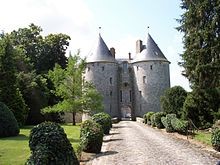
The Château de la Grange-Bléneau, commune of Courpalay – France. It was the « Home » of Lafayette, after the French Revolution. He lived there from 1802 until his death in 1834 in Paris, France.
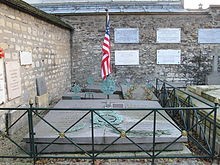
The grave of General Gilbert du Motier, Marquis de Lafayette in the Picpus Cemetery, Paris France. The American flag fly permanently over his grave in honor of the key role he played in the American revolution.
*FRENCH SUPPORT
France played a key role in the American Revolution (1765-1783)
and during the American Revolutionary War (1775–1783).
The American Revolution was a political upheaval that took place between 1765 and 1783 during which colonists in the “Thirteen American Colonies” rejected the British monarchy and aristocracy, overthrew the authority of Great Britain.
The Unilateral Declaration of Independence July 4th, 1776 is the statement adopted by the Second Continental Congress meeting at Philadelphia, PA on July 4, 1776, which announced that the “Thirteen American colonies”, then at war with the Kingdom of Great Britain, regarded themselves as thirteen newly independent sovereign states, and no longer under British rule. Instead, they formed a new nation, the United States of America.
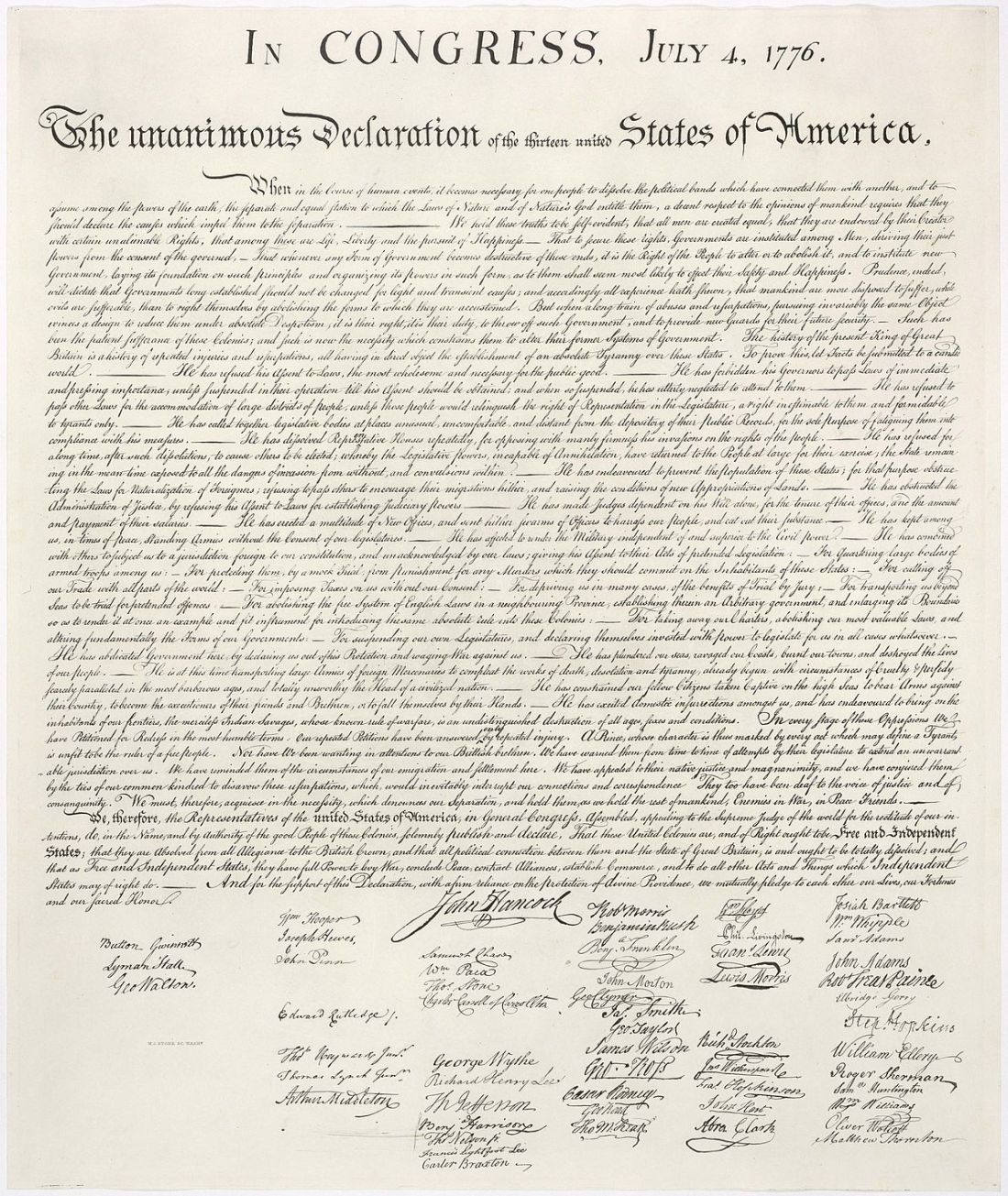
The original document of the unilateral declaration of Independence of the « Continental » United States of America (13 colonies of America) – 4th of July 1776.
*1775-1776-1777 : France secretly helps the American Insurgents
-In 1768: Baron de Kalb a Bavarian-born French military officer who served in the Loewendal German Regiment of the French Army, traveled to America on a covert mission to determine the level of discontent among colonists. He was sent to America by de Choiseul, (Chief Minister of the French King Louis XVI) on behalf of France. During the trip, he gained a respect for the colonists and their « spirit of independence ».
-In 1775: France began secretly sending supplies to the American Insurgents through different agents like Beaumarchais and French Secret Services.
-In 1776: At the beginning of the spring, France secretly sent military aid (predominantly gunpowder) through a company called “Rodrigue Hortalez et Compagnie”.
-In 1777: France had been sent secretly to the American rebels over five million “livres” of aid.
-1777: Battles of Saratoga / Stillwater, NY – A major turning point of the American Revolutionary War
First battle: September 19, Freeman’s Farm. British victory
Second battle: October 7, Bemis Heights. “American Insurgents” victory and British surrender.
News of Burgoyne’s surrender was instrumental in formally bringing France into the war as an American Insurgents ally, although it had previously given supplies, ammunition, and guns, notably the de Valliere cannon, which played an important role in Saratoga. Many estimates place the percentage of French supplied arms to the Insurgents in the Saratoga campaign up to 90%.

Saratoga (Stillwater, NY) Sept.19, 1777- Oct. 17,1777: Surrender of General Burgoyn General Daniel Morgan in front of a French « de-Valièere-4-Pounder canon »
*1778-1782 – France officially and fully aids the American Insurgents
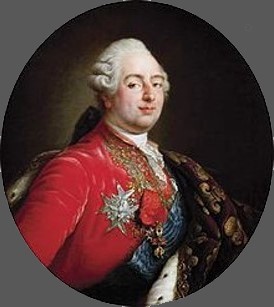
Louis XVI, King of France and Navarre 1774-1791. By A.F. Callet 1786
Prior to the Battles of Saratoga, France didn’t fully aid the colonists. However, after the Battles of Saratoga were conclusively won by the colonists, France realized that the “Americans” had a hope of winning the war, and began fully aiding the colonists by sending soldiers, money, donations, loans, military arms, supplies, and a Treaty was signed between the two parts.
February 6th, 1778 – Treaty of Alliance with France


Left: Original Franco-American treaty, signed February 6, 1778
Right: Text of the 1778 Franco-American treaty, in a 1782 publication.
The Franco-American alliance or Franco-American Treaty was signed between the Kingdom of France and the « Continental » United States of America (13 English colonies of America) during the American Revolutionary War. The two parts signed the treaty along with a “Treaty of Amity and Commerce” in Paris on February 6, 1778 (Ending in 1800). It was a defensive alliance between France and the “United States” and gave “open support from the French Army, Navy, and Treasury” to the “United States” in case of attacks by British forces indefinitely into the future.
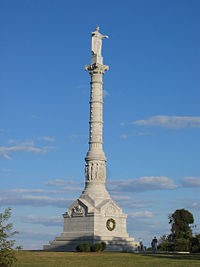
Monument to the Alliance and Victory at Yorktown VA (Today)
Later two countries became allies of France
-Spain in 1779 joined France in the war against the Kingdom of Great Britain implementing the Treaty of Aranjuez signed in April between France and Spain, but not with the American Rebels
-Dutch in 1780 joined France in the war against the Kingdom of Great Britain because on December 20, 1780, the English declared war to the Netherlands for their secret trade and negotiations with the 13 American colonies, then in revolt against the Kingdom of Great Britain.
*1st « French Expedition » in America under Comte d’Estaing 1778-1779
In the summer of 1778, French Admiral d’Estaing arrived with a fleet of 12 ships of the line, 14 frigates and infantry reinforcements for the war (4000 sailors and troops). The mission was to sail and fight along the American coast and Antilles until the end of the war (d’Estaing returned to France in Oct. 1779).
Comte d’Estaing, Admiral of the French fleet
*2nd « French Expedition » in America under Comte de Rochambeau 1780-1781/1782
On July 11, 1780, under the command of French Comte de Rochambeau arrived the « Expédition Particulière » a fleet and 6,000 French troops and sailors to join the Continental army, under George Washington.
Comte de Rochambeau, Marshal of France
The French Army in Newport, RI
The landing of a French auxiliary army in Newport, RI. on July 11, 1780.


Rochambeau Statue and Memorial about the Fench Expedition in New Port, Rhode Island. The monument is located on the waterfront in King Park, along the southern edge of Newport Harbor, near Brenton Cove and Fort Adams state park and was erected in 1934. From Wikipedia
« This is a monument to a French nobleman and General Jean-Baptiste Donatien de Vimeur, Comte de Rochambeau, who was a key commander of the French forces who assisted the Continental Army during the American Revolutionary War. »
The French Army in Yorktown, VA
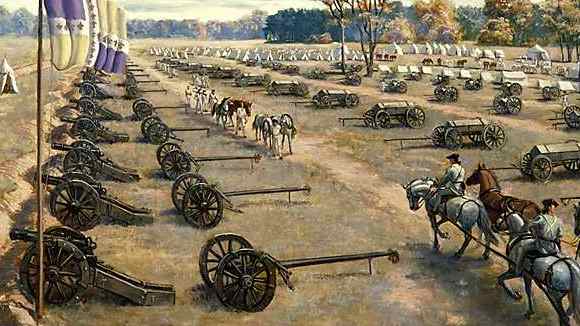
French artillery park at Yorktown, VA (Artist’s conception). The flag appears to be that of the French Régiment d’Artillerie d’Auxonne
The « Gribeauval system », and the « Canon de 12 », was first used for major operations in the American Revolutionary War, in Jean-Baptiste Donatien de Vimeur, Comte de Rochambeau’s French expeditionary corps, from 1780 to late 1782, and especially at the Siege of Yorktown in 1781. The Gribeauval system had been adopted by the French army on 15 October 1765 and supplanted a system established in 1732 by Florent-Jean de Vallière.
PLUS: The French Navy under de Grasse and the « Corps de troupe embarqué des Antilles » under Saint Simon join the Franco-American ground Forces of Washington and Rochambeau in Yorktown, VA
In 1781, the French Navy played a decisive role in supporting the Franco-American ground Forces and defeated a British fleet at the Battle of the Chesapeake in 1781, thus ensuring that the Franco-American ground forces would win the ongoing Siege of Yorktown, (September 28, 1781 – October 19, 1781) the last major land battle of the Revolutionary War.
(…But France continued to fight against the British in the « 1782 Antilles War.”)
Comte de Grasse, Admiral of the French Fleet
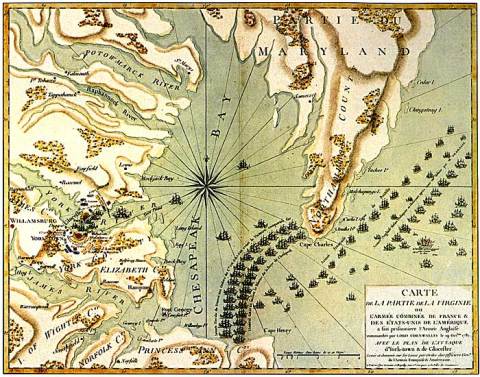
French Navy, Battle of Yorktown 1781
Even if their roles were closely linked, General George Washington in command of the allied Franco-American ground forces and Admiral François de Grasse in command of the French Fleet controlling the nearby waters (Blockage of the Chesapeake Bay by the French fleet), they met only twice. Both meetings were held on De Grasse’s Flagship, Ville de Paris. The first was on September 20 to complete planning for the attack on Yorktown and the other was on October 21 to explore future operations in the south. We can think that the Count of Rochambeau, the Marquis de Lafayette, and the Marquis de Saint Simon were part of the meeting.
The Battle of Yorktown, or the Surrender of Cornwallis

The Battle of Yorktown, ending on October 19, 1781, at Yorktown, Virginia, was a decisive victory by a combined force of American Continental Army troops led by General George Washington and French Army troops (Expdition particulière (5.500 soldiers) and three French regiment under General Saint Sinon (3000 soldiers ) transported from West Indies in September 1781 to the Chesapeake by the Count de Grasse) led by the Count de Rochambeau over a British Army commanded by British lord and Lieutenant General Charles Cornwallis.
After initial preparations, the Americans and French built their first parallel and began the bombardment. With the British defense weakened, Washington and Rochambeau on October 14, 1781, sent two columns to attack the last major remaining British outer defenses. A French column took redoubt #9 and an American column led by Lafayette took redoubt #10. With these defenses taken, the British situation began to deteriorate rapidly and Cornwallis asked for capitulation terms on the 17th. With the capture of more than 7,000 British soldiers, negotiations between the « United States » and Great Britain began, resulting in the Treaty of Paris in 1783.
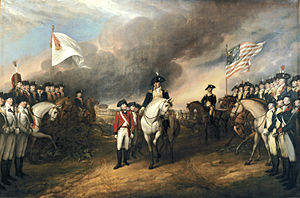
The surrender of Cornwallis
This painting depicts the forces of British Major General Charles Cornwallis, 1st Marquess Cornwallis (1738-1805) (who was not himself present at the surrender…), surrendering to French (left) and American (right) forces after the Siege of Yorktown (September 28 – October 19, 1781) during the American Revolutionary War. By John Trumbull, 1817, placed in the Rotunda of the US Capitol, Washington D.C. in 1826.
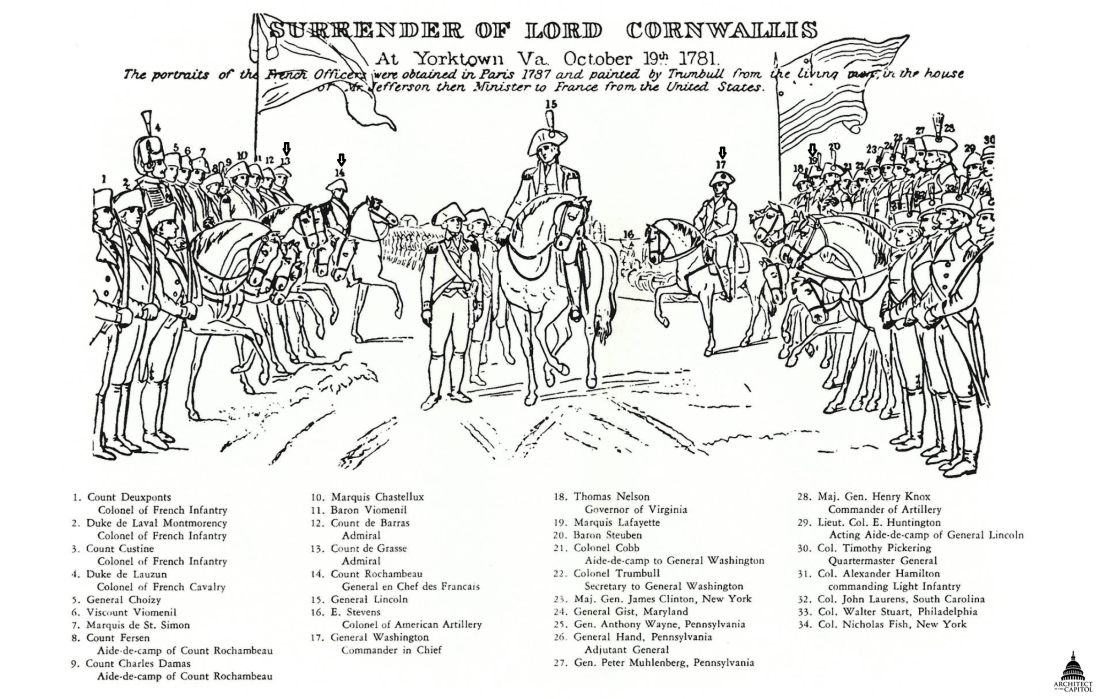
| In the center of the scene, American General Benjamin Lincoln (15) appears mounted on a white horse. He extends his right hand toward the sword carried by the surrendering British officer, General Charles O’Hara, walking on the right side of the horse who heads the long line of troops that extends into the background of the painting. British Major General Charles Cornwallis, 1st Marquess Cornwallis, General in chef of the British Army was not himself present at the surrender but represented by General Charles O’Hara. | |
| On the left side of the scene, French officers appear standing and mounted beneath the white banner of the French royal Bourbon family. Among them the Comte de Rochambeau (14) riding a brown horse, General in chief of the French Army “Expédition particulière” and Count de Grasse, Admiral in chief of the French Fleet (13). | |
| 1-Count Deuxponts: Colonel of French Infantry
2-Duke de Laval Montmorency: Colonel of French Infantry 3- Count Custine: Colonel of French Infantry 4-Duke de Lauzun: Colonel of French Cavalry 5-Marquis de Choizy: General 6-Vicont de Viomenil 7-Marquis de Saint-Simon |
8-Count Fersen: Aide-de-camp of Count Rochambeau
9-Count Charles Damas: Aide-de-camp of Count Rochambeau 10-Marquis Chastellux 11-Baron dViomenil 12-Count de Barras: Admiral 13-Count de Grasse: Admiral in chief of the French Fleet 14-Count de Rochambeau: General in chef of the French Army |
| On the right side of the scene, are American officers of the Continental Army beneath the Stars and Stripes; among them are General George Washington (17), riding a brown horse, Commander in chief of the French and American military alliance, and Marquis de Lafayette, Major General of the continental Army (19). | |
| 16-E. Stevens: Colonel of American Artillery
17-George Washington: Commander in chief of the Alliance 18-Thomas Nelson: Governor 0f Virginia 19-Marquis de Lafayette: Major General 20-Baon Von Steuben: General 21-Colonel Cobb: Aide-de-camp to General Washington 22-Colonel Trumbull: Secretary to General Washington 23-Maj. Gen. James Clinton, New York 24-General Gist, Maryland 25-Gen. Antony Wayne, Pennsylvania |
26-General Hand, Pennsylvania: Adjudant General
27-Gen. Peter Muhlenberg, Pennsylvania 28-Maj. Gen. Henry Knox: Commander of Artillery 29-Lieut. Col. E. Huntington: Acting Aide-de-camp of General Lincoln 30-Col. Timothy Pickering: Quartermaster General 31-Col. Alexander Hamilton: Commanding Light Infantry 32-Col. John Laurens, South Carolina 33-Col. Walter Stuart, Philadelphia 34-Col. Nicholas Fish, New York |
YORKTOWN, VA EMBLEMATIC MEMORY SPACE

NEW STATUES AND PLAQUES 2017
On October 18th, 2017, when the Lafayette statue joins Washington & de Grasse on the Yorktown waterfront, two new plaques will now be in place at their feet.
Go to » Virginia » for the text from these plaques.

« Lafayette gun. This Gun was taken by General Lafayette in person of the redoubt #10 at Yorktown in 1781. It is exposed in the Battlefield Visitor center of Yorktown, VA

« French Trench » Yorktown VA
(Memorial and bronze tablet)
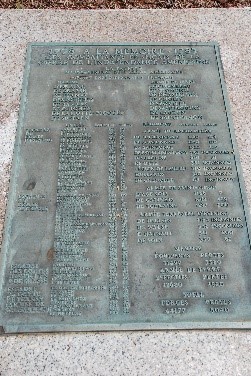
Between 1778 and 1783,
44 177 French soldiers and sailors fought aside the “American Insurgents”,
5 040 gave their live for their independence.
MAP OF THE LAFAYETE MEMORY SPACES IN THE USA
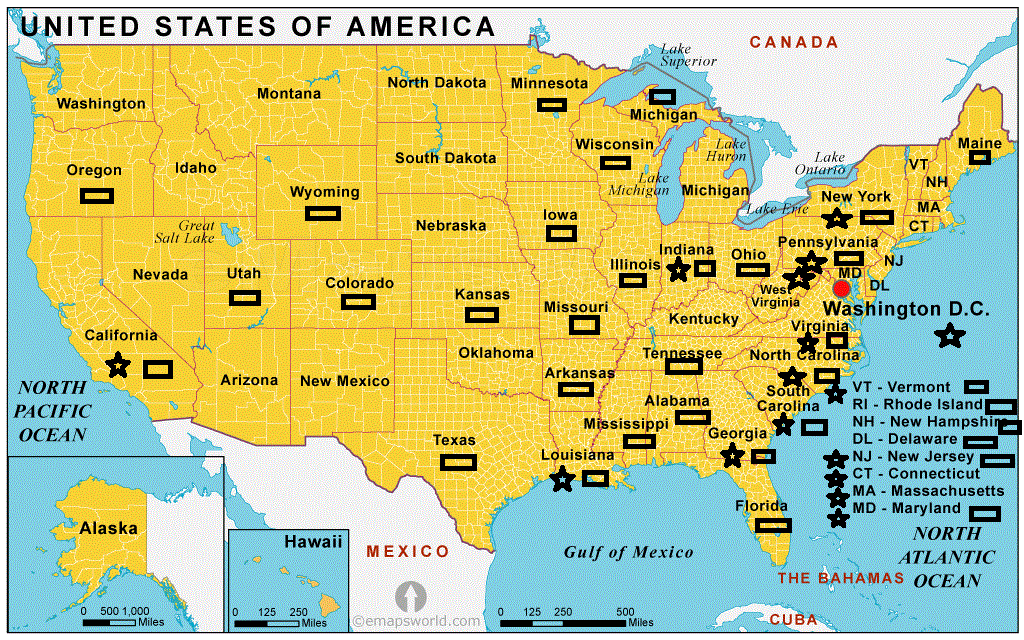
THE « FRENCH TOUCH » OF THE AMERICAN RÉVOLUTION
(Version française à la suite)
The fact that LAFAYETTE served in the continental army and not in the French army makes him a true « American hero », but undermines his direct and indirect historical role in the FRANCE’s commitment to the American Revolution. The LEGEND built by the American around him, culminating with his visit in 1824-1825 as per an invitation from the American Congress, is a recognition towards Lafayette and a hymn to the glory of the United States but not to France, the forgotten country without which nothing would have been possible …
The United States of America would certainly never have existed if Lafayette had not succeeded in convincing the king Louis XVI and his government to sign in 1778 a Treaty of Alliance with the Insurgents of the 13 English colonies of America. This treaty was the only one they could sign with a monarchy capable of fighting with comparable forces the British navy and army.
Indeed,
* Without the first military expedition under the command of d’Estaing,
* Without « the special expedition » under the command of Rochambeau,
* Without the French navy under the command of de Grasse,
* Without the numerous French and European officers recommended by France, having served in the Continental Army,
* Without the war material (guns, cannons, ships …) delivered by France,
* And without the funds provided by France!
The American Revolution would certainly not have achieved the victory of Yorktown, VA in October 1781!
Between 1778 and 1783,
* 44,177 French soldiers and sailors of the French military navy fought alongside the « American insurgents »
* 5,040 among them lost their lives for independence of the USA
* France spent 1.3 billion pounds (livres tournois), a huge contribution at the time that emptied the Kingdom coffers … and preceded its complete depletion during the French Revolution.
LA « FRENCH TOUCH » DE LA REVOLUTION AMÉRICAINE
Que LAFAYETTE ait servi dans l’armée continentale et non dans l’armée française fait de lui à juste titre un « héros américain », mais fait oublier le rôle historique direct et indirect qu’il a joué dans l’engagement de la FRANCE lors de la révolution américaine. La LÉGENDE bâtie par les Américains autour de lui avec comme point culminant sa visite de 1824-1825 réalisée sur invitation du congrès américain est un remerciement à Lafayette et un hymne à la gloire des États-Unis et non à la France la grande oubliée sans qui rien n’aurait été possible…
Les États-Unis d’Amérique n’auraient certainement jamais vu le jour si Lafayette n’avait pas réussi à convaincre Louis XVI et son gouvernement de signer avec les « Insurgés » des 13 colonies anglaises d’Amérique un Traité d’Alliance, le seul que les Insurgés aient pu signer avec une monarchie capable de combattre à égalité la marine et l’armée britannique.
En effet,
*Sans la première expédition militaire sous les ordres de d’Estaing,
*Sans « l’expédition particulière » sous les ordres de Rochambeau,
*Sans la marine française sous les ordres de de Grasse,
*Sans les nombreux officiers français et européens recommandés par la France, ayant servi dans les rangs de l’armée continentale,
*Sans le matériel de guerre (fusils, canons, vaisseaux…) livré par la France,
*Et sans les fonds envoyés par la France!
La révolution américaine n’aurait certainement pas connu le dénouement victorieux de Yorktown, VA au mois d’octobre 1781!
Entre 1778 et 1783,
*44 177 soldats et marins français ont combattu aux côtés des « Insurgés américains »
*5 040 ont donné leur vie pour leur indépendance
*La France a dépensé 1.3 milliards de «livres tournois », une somme énorme pour l’époque qui a vidé les «caisses » du Royaume… et engendré sa fin lors de la Révolution française.
LAFAYETTE FAREWELL TOUR IN THE USA, 1824-1825
The 24 states visited: Alabama, Connecticut, Delaware, Georgia, Illinois, Indiana, Kentucky, Louisiana, Maine (ex-Massachusetts / North part), Maryland, Massachusetts, Mississippi, Missouri, New Hampshire, New Jersey, New York, North Carolina, Ohio, Pennsylvania, Rhode Island, South Carolina, Tennessee, Vermont, Virginia. Plus Washington D.C.

DETAILED TIMELINE
1824
July 1824
- July 13 – Lafayette leaves France.
August 1824
- August 15 – Staten Island, New York.
- August 16 – New York City landing at Castle Garden.
- August 20 –New York City to Bridgeport/Connecticut, (Harlem, New Rochelle, Byram Bridge and Putnam Hill in Greenwich, Stamford, Norwalk, Saugatuck (Westport) and Fairfield)
- August 21–24 – New Haven/Connecticut; Providence/Rhode Island; Stoughton/ Massachusetts; and Boston/Mass
- August 25 – Cambridge, Massachusetts. Quincy/Mass. (Former president John Adams « Peacefield »)
- August 31 – Lexington, Concord, Salem, Marblehead, Newburyport, / Massachusetts.
September 1824
- September 1 – Portsmouth/New Hampshire.
- September 2 – Boston and Lexington/Massachusetts.
- September 3 – Worcester/Massachusetts, and Tolland/Connecticut.
- September 4 – Hartford and Middletown/Connecticut.
- September 5 – New York City.
- September 11 –New York City
- September 16 –Poughkeepsie/New York
- September 24 –Newburgh/New York.
- September 28 –Philadelphia/Pennsylvania
October 1824
- October 6 – Wilmington/Delaware
- October 12 –District of Columbia.[16]
- October 15 –Arlington House, and Washington/D.C. at night
- October 17 – Mount Vernon/Virginia
- October 18–19 – Petersburg/Virginia, for visit to Yorktown/Virginia
- October 19–22 – Williamsburg/Virginia
- October 22 – Norfolk/Virginia, Portsmouth/Virginia.
- October – Richmond/Virginia,
November 1824
- November 4 –Monticello/Virginia (former President Thomas Jefferson).
- November 8 – Charlottesville/Virginia
December 1824
- Early December – Washington/D.C.
- December 15 – Washington/D.C.
- December 17 – Annapolis/Maryland (visits Fort Severn).
- December 24 – Frederick, Maryland. (« Jug Bridge » crossing the Monocacy River on the National Pike).
1825
January 1825
- January 1 – Washington/D.C. (Congress)
- January 19 – Baltimore to Norfolk and Richmond/Virginia
- January 31 – Harrisburg, Pennsylvania (Perseverance Lodge #21)
February 1825
- February 23 –Suffolk/Virginia and Halifax/North Carolina (sandy « Lower Road » from Richmond to Raleigh)
- February 25 -Lafayette granted Poulson’s Advertiser an interview.
- February 26—Murfreesboro/North Carolina (first overnight in NC)
- February 27 – Northampton/NC (now the town of Jackson) and Halifax NC
- February 28 – Enfield/North Carolina (brief stop at home of Joseph Branch and Tar River at the falls (now Rocky Mount). Night at Rogers Crossroads/NC
March 1825
- March 1. Fayetteville/North Carolina
- March 2–3 – Raleigh, North Carolina
- March 15 –Charleston, South Carolina,
- March 18 – Beaufort, South Carolina, (John Mark Verdier House)
- March 19 –Savannah, Georgia.
- March 21 –Savannah, Georgia. (Johnson Square, memorial General Nathanael Greene)
- March 23 – Augusta/Georgia (up the Savannah River by steamboat)
- March 25 – Warrenton, Georgia (along the Milledgeville Stage Road)
- March 26 – Sparta, Georgia
- March 27 – Milledgeville, Georgia (capital of Georgia since 1804). Night at the Gachet house, Lamar County/Georgia.
- March 29 – Macon/Georgia (visits the Old Creek Indian agency in Crawford County, Georgia)
- March 30 – Night in a bark-covered log cabin (now in Chattahoochee County)
- March 31 – Crosses the Chattahoochee River into Alabama and stays in Fort Mitchell. Route west to Montgomery via military escort through Creek territory.
April 1825
- April 3 – Montgomery/Alabama
- April 4–6 – boards two boats, the Balize, and the Henderson, over the Alabama River (Selma, Cahaba, meet the French Vine and Olive refugee colony (now Demopolis). A brief stop in Claiborne.
- April 7 – Mobile/Alabama
- April 8 – boards steamboat down Mobile Bay to Mobile Point/Alabama and the original steamer Natchez (built in 1823) to New Orleans/Louisiana
- April 11 – Chalmette/Louisiana. New Orleans lodges in the Cabildo
- April 15 – On the steamer Natchez up the Mississippi River towards Baton Rouge/Louisiana
- April 16 – Brief stop Duncan’s Point, and Baton Rouge for a reception.
- April 18 – Natchez/Mississippi.
- April 28 – Carondelet/Missouri.
- April 29 – Louis/Missouri.
- April 30 – Kaskaskia, Illinois, (once the French capital of Upper Louisiana).
May 1825
- May 4 – Nashville/Tennessee.
- May 8–9 – The steamboat Mechanic, conveying Lafayette to Louisville/Kentucky, sinks on the Ohio. New steamboat Paragon.
- May 11 –Louisville/Kentucky . Jeffersonville/ Indiana. (Lafayette crosses the Ohio River from Louisville to spend a day He returns to Louisville that evening)
- May 12–13 – Louisville/Kentucky
- May 14 – Frankfort/Kentucky.
- May 15 – Lexington/Kentucky.
- May 16–17 – Lexington/Kentucky
- May 18 –Georgetown/Kentucky.
- May 19–20 – Cincinnati/Ohio.
- May 21 –Maysville/Kentucky.
- May 22 –Gallipolis/Ohio (Our House Tavern)
- May 24 – Wheeling/Virginia
- May 25 – Washington/Pennsylvania
- May 29 – Visits Braddock/Pennsylvania
- May 30–31 –Pittsburgh/Pennsylvania
June 1825
- June 1 –Butler/Pennsylvania.
- June 4 – Buffalo/New-York at Lafayette Square. (Lafayette follows Erie Canal from Buffalo across New York)
- June 7 – Rochester/New York.
- ………………
- June 17- Charlestown-Boston/Massachusetts. Lafayette lays the cornerstone of Bunker Hill Monument
- June 22- Dover, New Hampshire
- June 23 -South Berwick/Maine, Saco/Maine, Biddeford/Maine
- June 24 – Scarborough/Maine, Portland, Maine
- June 27 –Concord, New Hampshire and Claremont, New Hampshire.
- June 28—crosses into Vermont at the Cornish Passing through Woodstock, Barnard and Royalton, Vermont. Passes through Randolph, Barre to large festivities in Montpelier at The Pavilion.
- June 29-Burlington/Vermont. Lays Cornerstone UVM. Departs 12 hours after. Arrives to Whitehall/New York in the morning June 30.
July 1825
- July 14 – Morristown/ New Jersey.
- July 15 – Bottle Hill/New Jersey (now Madison) on his way to Springfield.
- July 20 –Germantown and Chestnut Hill/Pennsylvania
- July 25 –Wilmington, Delaware.
- July 26 – Chester/Pennsylvania, Brandywine Battlefield/PA West Chester/PA
- July 27 – Lancaster/Pennsylvania.
- Late July –Baltimore/Maryland, via Port Deposit and Havre de Grace, Maryland. Spends two days in Baltimore.
August 1825
- Late August – Lafayette returns to Mount Vernon/Virginia
September 1825
- September 6 – Washington, D.C.
- September 7 – Lafayette leaves Washington and returns to France on the frigate USS Brandywine.
crédit: Wikipedia.org
SUBMIT YOUR PICTURES AND NOTES
*JOIN THE RANKS OF OUR VOLUNTEER « REPORTERS » ON THE GROUND

« Nadar élevant la Photographie à la hauteur de l’Art » (Nadar Elevating Photography to Art).
Lithograph by Honoré Daumier, appearing in Le Boulevard, May 25, 1863.
Nadar was the pseudonym of Gaspard-Félix Tournachon (6 April 1820 – 23 March 1910), a French photographer, caricaturist, journalist, novelist, and balloonist (or, more accurately, the proponent of manned flight).
Photographic portraits by Nadar are held by many of the great national collections of photographs.
Nadar died aged 89. He was buried in Père Lachaise Cemetery in Paris.
Source: Wikipedia
This register is a collaborative website, open to active contributors of all ages, cultures and backgrounds.
This register is a permanent work-in-progress, with articles in various stages of completion. It updates and improves the quantity and quality by removing or repairing errors and misinformation.
Anyone with Internet access can send us pictures, articles, texts and references of their own and free of copyright restrictions.
People contribute with their real identity, without pay and copyright and become “ friend” of the organization if they agree
The Ordre Lafayette Order – Réseau America Network is a non-profit, non-political, non-religious organization and everyone can participate in the development of this vast register. It is about the Marquis de La Fayette and his decisive involvement during the Insurrection of the 13 English colonies in America against the British crown (American Revolution 1775-1783).
If you wish to participate in the realization of the “Lafayette Register”, in providing us with information, documents or personal photos, join our group.
*THIS WORKING DOCUMENT WILL BE MODIFIED AS MORE INFORMATION IS COLLECTED
For any question, contact: GC@gerardcharpentier.com
This is a bilingual organization. Express yourself in English or French.
C’est une organisation bilingue. Exprimez-vous en français ou en anglais.
06-20-2013: First public launching

